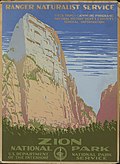Portal:Utah/Selected article/5
Zion National Park is a national park located in the Southwestern United States, near Springdale, Utah. A prominent feature of the 229-square-mile (593 km2) park is Zion Canyon, 15 miles (24 km) long and up to half a mile (800 m) deep, cut through the reddish and tan-colored Navajo Sandstone by the North Fork of the Virgin River. Located at the junction of the Colorado Plateau, Great Basin, and Mojave Desert regions, the park's unique geography and variety of life zones allow for unusual plant and animal diversity. Numerous plant species as well as 289 species of birds, 75 mammals (including 19 species of bat), and 32 reptiles inhabit the park's four life zones: desert, riparian, woodland, and coniferous forest. Common plant species include Cottonwood, Cactus, Datura, Juniper, Pine, Boxelder, Sagebrush, yucca, and various willows. Notable megafauna include mountain lions, mule deer and Golden Eagles, along with reintroduced California Condors and Bighorn Sheep.
In 1909, U.S. President William Howard Taft named the area a National Monument to protect the canyon, under the name of Mukuntuweap National Monument. However, in 1918, the acting director of the newly created National Park Service changed the park's name to Zion as the original name was locally unpopular. Zion is an ancient Hebrew word meaning a place of refuge or sanctuary. The United States Congress established the monument as a National Park on November 19, 1919. The Kolob section was proclaimed a separate Zion National Monument in 1937, but was incorporated into the park in 1956. (Full article...)

